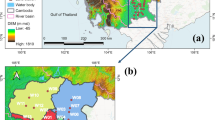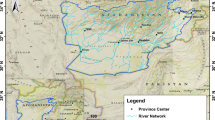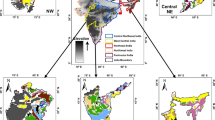Abstract
Groundwater is depleting at a more rapid rate than its replenishment in Indus Basin due to increased demand attributed to urbanization, inefficient water management practices especially in the agricultural sector and increase in impervious area in the name of development that can expose the country to severe challenge in the future. Through an unregulated groundwater exploitation now farmers often meet inadequacy in surface water supplies. The concurrent use of surface water and groundwater water now takes place on more than 70% of irrigated lands. Therefore, water resources should be monitored on frequent intervals to sensitize policy makers to formulate an optimal framework for water management practices. This study assessed the competence of Gravity Recovery and Climate Experiment Satellite (GRACE)—based estimation of changes in Ground Water Storage (GWS) as a substitute approach for groundwater quantitative approximation for management of groundwater resources in the Indus basin. The GRACE satellite Total Water Storage (TWS) data from 2011 to 2015 was used to calculate GWS. A common reduction trend was seen in the Upper Indus Plain (UIP) where the average net loss of groundwater was observed to be 1701.39 km3 of water amid 2011–2015. A net loss of around 0.34 km3/year groundwater storage was deduced for the UIP where flooding in 2014 assumed a fundamental part in natural replenishment of groundwater aquifer of the UIP. In view of TWS varieties three out of four doabs Bari, Rachna, Thal demonstrated a decrease in groundwater capacity though Chaj doab brought about increment of 0.09 km3. Based on this study, GRACE-Tellus satellite data is competent enough to hint for groundwater storage variations, however there is a vibrant need to calibrate GRACE-Tellus data with hydrological stations data periodically in order to take a maximum advantage for utility of GRACE to monitor groundwater variations on regional scale. Future studies should focus on this aspect.
Access provided by Autonomous University of Puebla. Download conference paper PDF
Similar content being viewed by others
Index Terms
1 Introduction
The imbalance between groundwater resource utilization and recharge has prompted water table to go down at an alarming rate according to past studies due to which several issues like insufficient water for agricultural use, groundwater siltation and land subsidence take place. The groundwater stressed areas need to be delineated on an optimal temporal scale to sensitize policy makers to develop strategies of water management practices on appropriate time groundwater and place. The Indus Basin has a vast groundwater aquifer that covers 16.2 million ha (hectare) [1]. Groundwater is pumped with the help of tube wells, currently numbered at 0.9 million and 87% of these are run on diesel, making groundwater pumping impractical during Pakistan’s frequent periods of power shortfall [2]. Since downstream is likely to continue to increase, precise hydrological projections for the future supply are important. The water resources supplied by the Upper Indus Basin (UIB) are essential to millions of people and future changes in both demand and supply may have large impacts [3]. The UIB provides water for the world’s largest continuous irrigation scheme through several large reservoirs (e.g. the Tarbela and Mangla dams. Water demands are high, primarily because of water consumption by irrigated agriculture, and hydropower generation. At the same time, the downstream part of the basin is characterized by very dry conditions, making it predominantly dependent on water supply from the upstream areas. The downstream demands exceed the supply and on an annual basis, groundwater resources are depleted by an estimated 31 km3, which makes the Indus basin aquifer the most overstressed aquifer in the world. According to recent studies the Himalayan glaciers will continue to retreat over the next 50 years and beyond because of climate change [4]. This will cause reduction of glacial mass, erratic snow patterns, unpredictable rainfall patterns, natural disasters and affected flow patterns in the Himalayan Rivers. The Indus River flows are greatly dependent on glacial and snowmelt (jointly termed melt water) and hence all the riparian’s will face the impact of climate change in the future [5]. Monitoring groundwater using conventional in situ geophysical methods, i.e. resistivity survey demands extensive efforts, time, and cost. These methods further limit the data applicability and reliability to generalize on a regional scale due to lesser spatial extent and insufficiency for interpolation. Remote Sensing and GIS technology is not only capable of quantitative but also qualitative water research [6] (Fig. 1).
2 Study Area
The Indus basin extent ranges Himalayan mountains in the north and stretches to the alluvial fields of Sindh province and streams out into the Arabian sea. The potential groundwater zones where utilization or abstraction is in excess lies in Punjab province plains popularly known as ‘Doabs’ that cover the area lying in between the adjacent 5 rivers Indus, Jhelum, Chenab, Ravi and Sutlej. The geographic extent of Punjab plains starts from 29.04°N to 34.2°N and 70.5°E to 75.4°E.
3 Data and Methods
In 2002, GRACE satellite provided opportunity to water managers globally to accurately estimate groundwater changes over the years at the regional scale. For regions of 200,000 km2 or more, GRACE can monitor changes in total water storage with an accuracy of 1.5 cm equivalent water thickness [7]. GRACE has the major advantage of sensing water stored at all levels, including groundwater. Unlike radars and radiometers, it is not limited to measurement of atmospheric and near-surface phenomena. In this study, we downloaded GRACE satellite product GRC Tellus JPL RL05 for the period 2010–2015. Each monthly GRC Tellus grid represents the surface mass deviation for that month relative to the baseline average over Jan 2004 to Dec 2009. A glacial isostatic adjustment (GIA) correction was applied based on the model from Geruo et al. [8]. A descripting filter was applied to the data to minimize the effect of correlated errors whose telltale signal are N-S stripes in GRACE monthly maps. A 300 km wide Gaussian filter was also applied to the data. All reported data are anomalies relative to the 2004.0–2009.999 time-mean baseline. A scaling factor of 1.26 was used in this study to recover the damped signals due to filtering. The soil moisture content (SMC), surface runoff (SR) data, canopy water storage (CWS) were derived from Global Land Data Assimilation System (GLDAS) land surface model (NOAH, CLM). The previous studies on the same area incorporated only two hydrological components and neglected canopy water storage. The GLDAS-Noah model provided soil moisture content in 4 distinct layers ranging from 0–10 cm, 10–40 cm, 40–100, and 100–200 cm. Therefore, all the layers data were stacked in ArcGIS environment to calculate cumulative soil moisture content. The spatial resolution of GLDAS-NOAH (1 * 1 Degree) was used so to match the pixel size of GRACE TWS data. The Noah model was preferred over CLM, VIC, Mosaic models because of greater accuracy in the Indus basin with slightly better precision.
3.1 Calculation of Gws
Derived outputs were added to calculate ‘surface water storage’ that was subtracted from TWS and thus GWS values obtained which was further plotted on graph for trend analysis and rates of variations were calculated. The areas which were below the mean value were highlighted as groundwater stressed areas. The GWS GRC Tellus JPL RL05 data units are centimeters of equivalent height of water. Therefore, it was converted to millimeters to be comparable to the rest of hydrological components. The used equation for the calculation of GWS is as below:
GWS = Groundwater Storage (water equivalent height in mm)
SR = Surface runoff (kg/m2)
SMC = Soil Moisture Content (kg/m2)
CWS = Canopy Water Storage (kg/m2)
The GWS was again converted to its native units (cm) for generation of maps.
3.2 Calculation of Annual Gws Variations
GWS data obtained by the previous step for each month from 2010 to 2015 (except for the missing 15 months due to data outages). The annual GWS mean raster for each year was generated at spatial resolution of 1 * 1 degrees. The annual mean of each year was then converted into GWS variations by subtracting the preceding year GWS raster with subsequent year. The equation for the GWS variation calculation is as below:
∆GWS = GWS variation,
Annual Mean T × 2 = Proceeding Year GWS annual mean raster
Annual Mean T × 1 = Subsequent Year GWS annual mean raster
The raster’s of groundwater storage variations were then downscaled to 0.0154 * 0.154 m using geo-statistical method Kriging by converting raster’s into point data and applying ‘Kriging’ interpolation technique that tends to reduce variance (Fig. 2).
4 Results and Discussion
The mean annual groundwater storage variation data of UIP for the year 2011 showed almost similar trend for all UIP doabs with varying intensity. Bari doab showed an increase of 1.71 cm, Rachna 1.36 cm, Chaj 1.58 and Thal 0.50, respectively. Therefore, an overall increase of 5.15 cm was observed for UIP. The recharge impact could be attributed to heavy flooding in the subsequent year 2010 and a greater recharge rate due to precipitation greater than the groundwater abstraction rate. The decrease in groundwater equivalent height compared to subsequent year could be because of higher abstraction rate as compared to that of recharge. The UIP mean groundwater storage variation data for 2013 showed negative change in all UIP doabs.
Bari doab showed a decrease of 4.1 cm, Rachna 3.5 cm, Chaj 2.9 and Thal 2.6 cm respectively. In terms of volume, 17.78 km3 of decrease in groundwater was observed for UIP. The decrease in groundwater equivalent height compared to subsequent year could be because of higher abstraction rate as compared to recharge rate.
The mean groundwater storage variation data of UIP for 2014 showed a notable rise in water equivalent height of all doabs. That is of course attributed to a heavy flooding in this year across UIP that inundated massive area of Bari doab. Bari doab showed a decrease of 4.1 cm, Rachna 3.5 cm, Chaj 2.9 and Thal 2.6 cm respectively. In terms of volume, 17.73 km3 of increase in groundwater was observed for UIP that almost recompensed the deficit of 2013. The increase in groundwater equivalent height compared to subsequent year was due to extreme rainfalls during 2014 (Table 1).
The mean GWS variation data of UIP for year 2015 showed positive change in all doabs of UIP except for Thal doab. Bari doab showed an increase of 1.2 cm, Rachna 1.4 cm, Chaj 2.2 whereas Thal a decrease of 2.6 cm respectively. In terms of volume, 6.09 km3 of increase in groundwater was observed for UIP. The increase in groundwater equivalent height compared to subsequent year could because of higher amounts of rainfall recorded in 2015.
The mean GWS variation UIP data for 2011–2015 showed a decrease in all doabs of UIP except for Chaj doab. Bari doab showed a decrease of 0.23 cm, Rachna 0.37 cm, Chaj an increase of 0.73 cm whereas Thal a decrease of 1.38 cm, respectively (Fig. 3).
Interestingly, if we breakdown the data in pre and post flooding time zones, from 2011 to 2013 there was a neat decrease of 18.79 cm (0.6 ft). A high jump of 13.06 cm in 2014 has replenished the groundwater aquifer of UIP to a great extent. However, the proportion increase never remained same in 2015 and a net increase of 4.48 cm was observed. The net groundwater storage variation was divided into three equal interval zones I, II and III indicating areas of high, medium and low groundwater stress respectively. Based on the findings of the study, groundwater pricing policy must be adapted as there exists no market for groundwater and ownership laws also need to be passed and implemented to curb excessive groundwater mining. A zone wise management concept must be introduced in groundwater management. Future studies should focus on formulating a credible scale/index to calculate water stress in a watershed (Table 2).
For agricultural purposes, it must be ascertained that groundwater is exploited as per crop water requirement of respective crop. Water delineation plants are the need of the hour in order to achieve water security in Pakistan.
The water reuse by industries and agriculture could be the possible solution to meet future water, agricultural and Industrial needs. Water desalination plants could play a role of game changer in such crucial stage where the country is on the brink of becoming water bankrupt.
In order to predict future water availability-demand scenarios, the socioeconomic digital data repository or geo-database generation is also required to have a better insight (Table 3).
References
Iqbal, N., Hossain, F., Lee, H., Akhter, G.: Satellite gravimetric estimation of groundwater storage variations over Indus Basin in Pakistan. IEEE J. Sel. Top Appl. Earth Obs. Remote Sens. 9(8), 3524–3534 (2016). https://doi.org/10.1109/JSTARS.2016.2574378
Ashraf, A., Ahmad, Z.: Regional groundwater flow modelling of Upper Chaj Doab of Indus Basin, Pakistan using finite element model (Feflow) and geoinformatics. Geophys. J. Int. 173(1), 17–24 (2008). https://doi.org/10.1111/j.1365-246X.2007.03708.x
Shakeel, M., Huk, S., Mirza, M.I., Ahmad, S. Monitoring waterlogging and surface salinity using satellite remote sensing data. In: International Geoscience and Remote Sensing Symposium, 1993. IGARSS’93. Better Understanding of Earth Environment, vol. 4, p. 2029. https://doi.org/10.1109/igarss.1993.322360 (1993)
Ali, I., Shukla, A. A knowledge based approach for assessing debris cover dynamics and its linkages to glacier recession. In: 2015 IEEE International Geoscience and Remote Sensing Symposium (IGARSS), pp. 2072–2075. https://doi.org/10.1109/igarss.2015.7326209 (2015)
Kwak, Y., Park, J., Fukami, K.: Near real-time flood volume estimation from MODIS time-series imagery in the Indus River Basin. IEEE J. Sel. Top Appl. Earth Obs. Remote Sens. 7(2), 578–586 (2014). https://doi.org/10.1109/JSTARS.2013.2284607
Barros, A.P.: Water for food production—Opportunities for sustainable land-water management using remote sensing. In: IGARSS 2008—2008 IEEE International Geoscience and Remote Sensing Symposium, vol 4, IV-271–IV-274. https://doi.org/10.1109/igarss.2008.4779710 (2008)
Chambers, D.P.: Calculating trends from GRACE in the presence of large changes in continental ice storage and ocean mass. Geophys. J. Int. 176(2), 415–419 (2009). https://doi.org/10.1111/j.1365-246X.2008.04012.x
Geruo, A., Wahr, J., Zhong, S.: Computations of the viscoelastic response of a 3-D compressible Earth to surface loading: an application to Glacial Isostatic adjustment in Antarctica and Canada. Geophys J Int. 192(2), 557–572. https://doi.org/10.1093/gji/ggs030 (2013)
Author information
Authors and Affiliations
Corresponding author
Editor information
Editors and Affiliations
Rights and permissions
Copyright information
© 2019 Springer Nature Switzerland AG
About this paper
Cite this paper
Amin, M., Khan, M.R., Jamil, A. (2019). Quantification of Groundwater Storage Variations and Stressed Areas Using Multi-temporal GRACE Data: A Case Study of Upper Indus Plains, Pakistan. In: El-Askary, H., Lee, S., Heggy, E., Pradhan, B. (eds) Advances in Remote Sensing and Geo Informatics Applications. CAJG 2018. Advances in Science, Technology & Innovation. Springer, Cham. https://doi.org/10.1007/978-3-030-01440-7_68
Download citation
DOI: https://doi.org/10.1007/978-3-030-01440-7_68
Published:
Publisher Name: Springer, Cham
Print ISBN: 978-3-030-01439-1
Online ISBN: 978-3-030-01440-7
eBook Packages: Earth and Environmental ScienceEarth and Environmental Science (R0)







